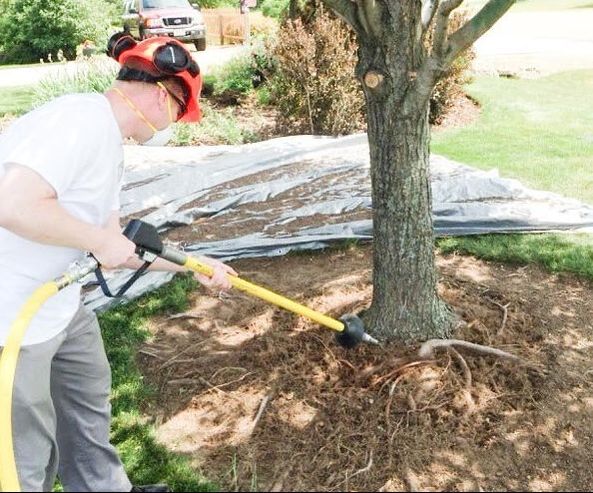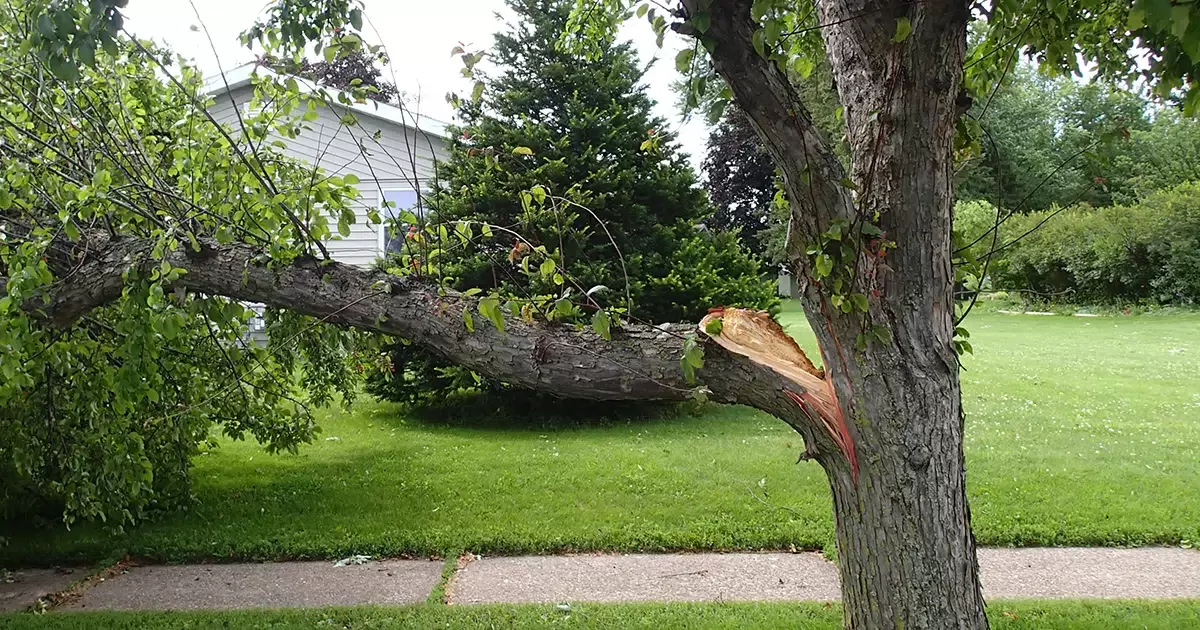Plant Health Care
Landscape EvaluationThe modern arborist considers each plant in the landscape as merely a part of the larger environment they inhabit because the condition of any one plant, shrub or tree is rarely unrelated to the condition of its botanical neighbors.
The Condition of these neighbors often provides vital clues about the landscape’s hydrology, soil chemistry and abiotic activities. Plant Healthcare Solutions is dedicated to achieving the optimal condition of your trees and shrubs therefore it is serves to observe the landscape as a whole. Trees and shrubs require a routine of examination just as people; a proactive measure to discover existing and potential concerns. Most infections, infestations and disorders of our trees and shrubs are discoverable long before they become a significant hindrance to vitality. This is why our approach includes consistent re-examination of the landscape each visit. Observing an issue early and proactively can also save the landscape from costly spray or removal operations. Let us inspect your trees and shrubs for free to avoid potential disaster. |
Flea - Tick- Mosquito- DeerTicks, mosquitoes and deer are much more than an annoyance. Our area has seen a dramatic increase in tick-borne diseases, including Lyme Disease, Ehrlichiosis, Babesiosis and the Powassan virus. We off a safe, effective tick, mosquito and deer control for your property. We offer a range of treatment options including organic programs. Our
arborists and technicians are licensed in pest management and also understand how to make your property less hospitable to ticks, mosquitoes and deer. With tick populations on the rise and the incidence of Lyme carrying deer ticks also increasing, the benefit of their control can be life-saving. The judicious application of pesticide towards this pest can also be life-saving for your landscape. Excessive repeat application, mis-application, cover-spraying, and haphazard treatment methods can cause collateral damage to the beneficial insect community as well as disrupt the natural order of the ecosystem. Plant Healthcare Solutions can maximize the safety of your outdoor living spaces without causing undo harm to the landscape. Got Deer? Effective control of deer browse need not be expensive. Adapting treatment plans to patterns of browse ensures that excessive and unnecessary applications are avoided. Jersey Premier knows all too well the effect whitetail deer can have on a manicured landscape. A single whitetail deer is capable of eating over five pounds of foliage in a day. Timely applications can deter feeding on your plants by making this foliage unappetizing. However, deer populations vary in their preferred diet. Observation of your landscape will determine which plants require treatment and how often it should be applied. Treatments can last as long as several months depending on the season and weather. Elimination of wasteful applications by supervising the changes in feeding habits and adaptations to diet which may occur after initial control. |
Tree SprayingTree spraying is a common preventative tree care practice that involves chemical and fungal applications to keep nuisance, damaging pests away. It is a very important part of your tree care routine, especially if you live near wooded or forested areas, or near a large body of water. Insects like beetles, spiders, mites, and more are common threats to both deciduous and evergreen trees, so tree spraying is a method that can help protect trees and withstand the surrounding nuisance insect threats all year long.
Not all trees will require spraying; it is important to discuss your individual tree care needs with a licensed tree service contractor who can give you professional recommendations for your unique landscape. Common Benefits of Tree SprayingAs mentioned, tree spraying protects trees from nuisance pests, keeping them healthy and lush all season. But there are a few more advantages of spraying trees. It also wards of tree diseases like fungi, bacteria, and other infections. It also helps control the spread of these diseases. |
Deep Root FertilizationDeep root fertilization is a blend of essential nutrients that help to restore soil health. These are some of the elements found naturally in forest soil, which residential landscapes tend to lack. When this fertilizer is injected into the soil, it makes its way deep down into the tree’s root zone where it is needed. By delivering a high-quality liquid-suspended fertilizer, the product is ultimately distributed throughout the tree in a process called translocation.
While your tree would survive without deep root fertilizer, it’s never going to thrive or perform its best. It might also be more susceptible to certain problems like insects and diseases. On the same token, people sometimes ask: Does deep root fertilization work? We get it…you don’t want to invest in something if it’s not really that big of a deal or not going to work that well. But we can attest that we’ve seen with our own eyes how much better trees perform when they are properly fertilized. |
Tree PreservationTree preservation encompasses a host of services and is required in many situations but is most common on valuable trees and on selected plants occupying proposed construction areas. Trees about to be in the throes of construction may require special cordoning to prevent aboveground damage, mitigation of traffic patterns, installation of temporary weight displacement materials, irrigation, special pruning, physical and chemical soil analysis, detailed inventorying and most importantly a management plan to facilitate and ensure the above measures are fulfilled at the appropriate interval. Some trees are so significant to their respective property, that the demand for their longevity warrants advanced care regardless of construction. Certain species require special treatment because of environment or a unique pest. Open-grown species advanced in age, that meet some or all of these qualifications may receive in addition: microinjection macro infusion to ward off insect and vascular disease, major root invigoration to stimulate fine-root development and bracing, cabling to support large defects.
|
Weed - Pest ControlControlling weeds can be as simple as knocking down a finite area in preparation of a future project or eliminating specific invaders over many acres. No matter the scope, Jersey Premier has the appropriate strategy to ensure a sustainable outcome at an affordable rate. Often an area is overrun by invasives. Invasive plants are species which dominate an environment preventing other long-established species from maintaining their presence in the the ecosystem. Advantages in growing season, cold tolerance and soil tolerances allow these species to invade and overwhelm the natural community of plants.
|
Spotted Lantern Fly (SLF)The spotted lanternfly (Lycorma delicatula): is a planthopper indigenous to parts of China and Vietnam. It has spread invasively to Japan, South Korea, and the United States. Its preferred host is tree of heaven (Ailanthus altissima), but it infests crops including soybean, grapes, stone fruits, and Malus.
Property owners can help contain and control spotted lanternfly (SLF) by implementing a management strategy using a combination of mechanical control, host reduction, and chemical control. These guidelines have been developed for use by the Pennsylvania Department of Agriculture (PDA) Spotted Lanternfly Eradication Program. The guidelines target SLF at different stages of its lifecycle, and may lead to dramatic reduction in SLF populations where implemented. |
Air SpadingAir spading is a process used by arborists to combat a common issue effecting trees – soil compaction. If your trees aren’t looking the healthiest, it could be down to soil compaction, an issue impacting many urban trees in our area. Air spading is a non-invasive treatment for soil compaction, offering many advantages for your tree’s health!
Air spading is a process used to reverse the effects of soil compaction on trees. Soil compaction is when the soil around the root system of tree becomes too tight and compacted. There are various causes, from heavy foot traffic to lawn maintenance, with the effects often taking years to fully appear. Eventually, the soil becomes so compacted that it has less space to hold air and moisture. Trees require an abundance of air and water to remain healthy, so soil compaction becomes a serious issue for tree health. Air spading involves using high-pressure jet sprays to reduce compacted soil beneath a tree. The air spade nozzle is inserted into the soil around the base of the tree, spraying compressed air to loosen the compacted soil. Due to the pressure of the air spade, soil becomes less compacted, taking on a crumblier consistency. Crumblier soil allows more air and water to pass through the tree roots, ensuring maximum nutritional intake for optimal tree health! The air spade is completely safe to use, causing no harm to the tree’s root. In fact, it allows for easier root inspection, where you can determine if the roots need pruned to encourage better development. Basically, air spading offers many benefits for tree health, while being a quick and easy process to complete. |
Tree Risk AssesmentThere are many conditions that increase the likelihood that all or part of a tree will fail. In urban and suburban settings, the failure of a tree often leads to property damage and/or personal injury. Inspecting mature trees periodically for hidden decay, structural weaknesses and diseases can extend their lives and mitigate the risk of failure of the tree or its branches. Falling trees and branches can cause serious injury to people and extensive damage to property. There are many conditions that increase the likelihood that all or part of a tree will fail. In urban and suburban settings, the failure of a tree often leads to property damage and/or personal injury. Inspecting mature trees periodically for hidden decay, structural weaknesses and diseases can extend their lives and mitigate the risk of failure of the tree or its branches. Falling trees and branches can cause serious injury to people and extensive damage to property. It takes a trained and experienced arborist to inspect a tree, conduct the required testing and interpret the results accurately. The TRAQ system utilizes a detailed tree risk assessment form that arborists complete while inspecting trees on a property. In addition to basic data, such as species, diameter of the tree at breast height (DBH), tree height and crown spread, it also requires the arborist to record and evaluate other detailed information about the location, conditions, defects in the tree’s trunk, crown, and roots, as well as potential targets if the tree or its branches fall. Based on this information, as well as results of other testing, using specialized tools such as a Resistograph the arborist is able to create a comprehensive report that offers a complete analysis of each tree and its risk of failure.
When tragedy befalls important trees, there are restorative measures beyond pruning which may be employed. These measures are best applied before failure occurs and thus preventing the catastrophic event entirely. |
ConsultingHomeowners often require a consultant to guide their decision making processes with trees. Whether your concern is for a single tree or the entire landscape, Jersey Premier can provide the appropriate advice. Consulting produces written reports, tree and shrub management plans, tree risk assessments and compatible planting suggestions. Tree and shrub management plans are beneficial to complex landscapes, large and small, with numerous issues. All reports start with observing, recording and prioritization of assets in the landscape. Risk assessment is of particular importance in ensuring the safety of people and property. We provide reports as a qualified tree risk assessor. Planting trees appropriate to a site and provided adequate aftercare are a far greater investment due to higher rates of establishment and annual growth. With expert advice, at an affordable rate, planting suggestions and support can save a property owner thousands.
|
WHY JERSEY PREMIER
CUSTOMER REVIEWS
Ready to Get Started
Come see the difference our high quality services can make.
|
Jersey Premier
3015 S White Horse Pike, Hammonton NJ, 08037 Phone: (609) 878-3315 NJDCA#13VH09983500 NJ DEP Irri. Lic. #719744 NJ Pest # 91114B NJTC # 801620
|
|


















